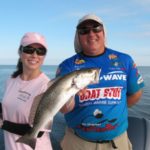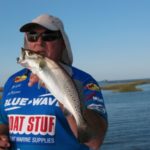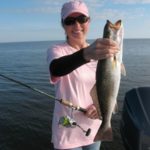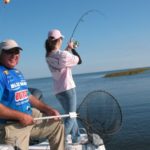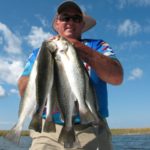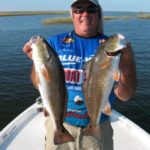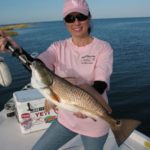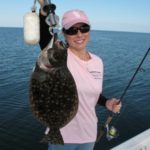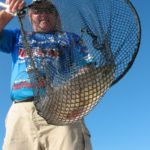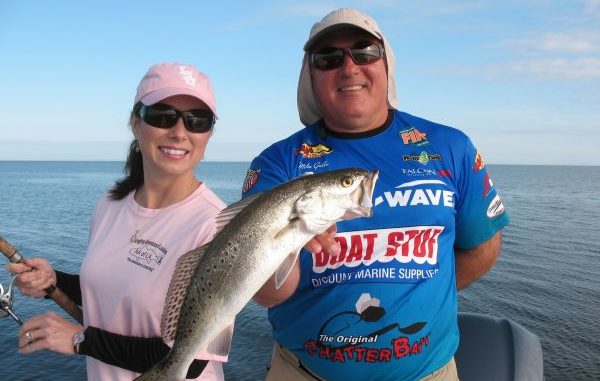
When a live shrimp finds itself in the wrong part of the Biloxi Marsh, things can get violent. And anglers can use that knowledge to put a lot of fish in their boats this month.
Whenever I fish with Capt. Mike Gallo, we always bring a third man along. There’s plenty of room in his 24-foot bay boat, plus it means an extra set of hands and a third line in the water to increase our chances of catching something picture worthy.
Besides, I like a third party aboard because it gives me another face to photograph besides that of a windblown sun-beaten charter captain. Usually Gallo will invite a friend or customer along, or occasionally I’ll drag someone with me.
But on this trip it was Mike’s turn to provide the third man, and he was surprised to find no takers.
“Everybody had one excuse or another: They were too busy, couldn’t get off work, one was out of town, another was sick — I was at the end of my list,” Gallo said. “I was just about to ask my wife if I could keep our son home from school to go fishing when she said, ‘I’ll go!’”
So when I pulled up to Gallo’s camp on Salt Bayou, he and his wife Jackelyn were ready to do some fishing. So our third man was, well, a woman.
And a pink-clad girly girl. Not a silly, giddy girl, mind you, and certainly not a manly girl, but a very pretty, very feminine woman, who, it just so happens, loves to fish.
And, as I was soon to learn, she was very good at it.
Mike Gallo pointed the bow toward Rigolets Pass and then into Lake Borgne toward the Biloxi Marsh, where he likes to work along the bank of Lake Borgne itself for reds and specks and where some interior lakes, lagoons and ponds are known to hold some good fish.
“Today I’m taking you to fish in some bad neighborhoods, and I do mean bad neighborhoods where there’s a lot of violence — and I’m hoping today will be a very violent day,” he said with a grin. “We have a baitwell full of some frisky live shrimp for bait, and I want to find the most dangerous neighborhood in the area to be a shrimp, and that’s where we’ll send them out for a stroll.”
Now that live-bait trawlers are allowed to drag for live shrimp all year, many bait shops and marinas should have shrimp for sale this month. Normally we’d have to wait until mid- to late May for live shrimp, but Gallo had a tank full and we were eager to put them out in a violent neighborhood.
“April is a whole lot like October in that both are transition months,” he said. “The fish aren’t where they were during the winter, and they’re not yet where they’re going to be in the summer. They’re in transition, somewhere in the in between.
“So, since the two months sort of mirror each other, try to remember where you caught fish in October and you’ll likely catch them there again in April.
“The fish all have patterns, and they don’t much deviate from those patterns. They will likely be scattered, so you’ll probably have to do a lot of moving around, picking up a few here and a few there until you put together a decent box of fish.”
Gallo idled the Pure Bay along the broken shoreline of Lake Borgne near Bayou Biloxi, where the water was clean. He said he did well in that area in October, so it should be good now.
He dropped the trolling motor over the bow, and we loaded our hooks with some healthy live shrimp under corks and tossed them into what looked to be a bad neighborhood.
It didn’t take long for violence to break out, as a hefty redfish inhaled Jackelyn’s shrimp.
“It’s violent down there if you’re a shrimp,” Gallo said as he scooped the fish up in the landing net.
A few minutes later we picked up another.
Gallo worked the boat along the shoreline, mostly concentrating on coves and points and any broken marsh islands, and we picked up a few trout off the points and a nice flounder sitting right on a prominent point.
“Flounder are ambush predators,” the guide explained. “They don’t really swim along trying to chase down something to eat. They prefer hard sand bottoms where they can lay half buried at points with current moving around them and along ledges, and they wait for a shrimp or baitfish to come along in the tide, and then they pounce and just gulp it down.”
When the action slowed down to a trickle, Gallo moved us up into Bayou Biloxi to search for more reds and, hopefully, some specks.
“April can be warm or cold, so where you go will depend on the weather,” he said. “If it’s still cool, the trout will stay pretty close to the deeper bayous, but they’ll be spread out over the flats and reefs and along shorelines foraging for food. You definitely want to try the bigger lakes and lagoons, like the lakes of Bayou Marron, Bob’s Lakes, Lake Eugene and Poodle Lake (which, of course, looks like a poodle), and there’s a ton of nameless ponds out here, all of which can hold fish.”
Some of these little ponds can be very shallow.
“If you’re unsure of a pond’s depth don’t go roaring in with the outboard. Troll in and you’ll soon know if it’s deep enough to fish in,” Gallo said. “Once in, look for a few essential things: clean water, moving tide and signs of life in the water.
“I used to say look for baitfish or schools of mullet, but time and experience has taught me that any sign of life in the water — crabs, minnows, mullet, even the swirl of a garfish — is worth checking out. Throw your bait toward the life and see if a good fish will hit it.”
Gallo trolled into a big, nameless pond and kept the boat a long cast away from the shore so we could throw toward the bank for redfish or toward the middle for trout. We did both, and we caught both.
“I’ll drift these lagoons and ponds, just using the trolling motor enough to control my drift,” he said. “I like to have everyone under a cork, fishing both sides of the boat, and if we get a good fish I stick the Power-Pole down and we see if we can pick up a few in that spot.
“When the fish are scattered like they are this time of year I definitely stick when I catch one rather than drift past it, because sometimes that one spot will have some bottom feature that holds them there, like a ridge or hump or shell bottom. So give it 10 minutes or so, and if nothing else bites pull up and resume drifting.”
Gallo said if those more disposed to drifting through an area rather than sticking when a fish is caught can go back a second and even third time and redrift that area.
“Just remember that you’ll always catch more fish on the first drift, and the second drift you catch less and less again on the third,” Gallo said. “The only thing you can do to keep your odds of catching up is to slow your drift down with a drift sock or a five-gallon bucket.”
Now Gallo is a non-stop talker, which keeps his guests engaged and informed, while his wife Jackelyn just kept fishing — and catching.
She needed no assistance, baiting her own hook, making all her own casts and —truth be told — probably out-catching both of us.
My excuse for being out-fished by a girl is that I had to keep stopping to take pictures, which I think is a legitimate excuse.
Mike, on the other hand had no excuse. A fact I intend to remind him of — frequently.
We moved into the lakes of Bayou Marron, drifting within a long cast’s distance of the shoreline, and Gallo used the trolling motor just enough to allow us to focus on the points.
“The trout will hang off the points, not right on them,” he said. “They could be anywhere from 10 feet to 20 or 30 yards off the points, especially where you see current lines that form up behind a point. Those tend to be violent neighborhoods, so send your bait over there and see if a speck will attack it.
“Or you can throw right up to the point or on either side of it as close to the grass as you can get; redfish prowl right along the bank, and if they see a shrimp hanging out in their neighborhood something violent is going to happen.”
And violence broke out quickly on both sides of the boat, so we had found what we hoped for: a really bad neighborhood. Trout were in the middle and reds were against the shoreline, and we were tossing shrimp right into the middle of the fray.
It was a bad day to be a shrimp.
“What you want to look for this month is patterns,” Gallo said. “Pay attention to where you caught a fish. Was it off a point or along a current line or just past or just before a cut?
“It’s important, because when you fish out that productive spot you want to look elsewhere for a place that duplicates that same pattern. Look in the same pond or lagoon for similar features, or move to a nearby pond that has similar features.”
Every detail of a catch is important.
“It’s not just the obvious features you’re looking for, but even the depth of the water is important,” Gallo said. “If you catch fish in 2 feet of water, you want to find a nearby body of water with the same basic depth because that, too, is part of the pattern they’re in.
“Here’s where a knowledge of the area you’re fishing comes in real handy.”
Gallo said that, while live shrimp is the best bait this month, it’s not your only option.
“Keep in mind this is still early in the year for shrimp, so if the marinas and bait shops have live shrimp, they may be small,” he said. “But don’t let that discourage you from getting some because that’s what’s in the water right now, that’s what the fish are feeding on and they will smack that small shrimp violently.
“I know you won’t turn your nose up at a small piece of candy like an M&M or a Hershey’s Kiss just because it’s small. You’ll gobble it right down. Well, the trout and reds will devour those small shrimp. Believe me, they won’t turn them down.
“But you can also fish plastic this month. Dudley came out with a couple of new colors I really like, especially the mojo mullet, and the opening night and blue moon colors are staples.”
His rig is nothing secret.
“I’ll fish them on a ¼-ounce jig between 18 and 24 inches under a popping cork while drifting or trolling,” Gallo explained. “Remember: You have to move when you’ve fished a spot out.
“Catch them as long as they’re biting in that spot, but when the action dies you can’t sit there: You have to move to another spot with those similar features.”
And forget about fishing deep water this month, he said.
“They’ll be prowling over shallow flats and reefs and around points foraging for food,” Gallo said. “It’s also a good month for fishing topwater baits and shallow-swimming hard baits.
“And personally I like to fish an incoming tide. Yes, you’ll catch on any tide — rising or falling — but my preference is a rising tide, bringing in clean water and bait.”
He said he refers to the Louisiana Sportsman tide charts , noting the times marked in black.
“That’s what we call ‘force speed,’ when the tide is moving above two-tenths, just sweeping the baitfish and shrimp along with the current,” Gallo said. “The reds and specks will set themselves up at logical ambush points and wait for victims to come by.
“That’s where you want to cast your line. Right there into that bad neighborhood, and hope for some violence on the end of your line.”
Capt. Mike Gallo can be reached at 504-259-3474.
